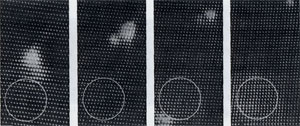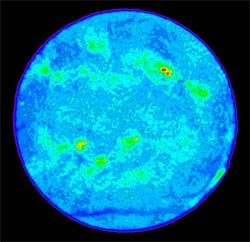
Sun-Earth Day Presents: Eclipse, In a Different Light
A thousand years of scrutiny with visible light did not prepare scientists for what they would see at other wavelengths.
TECHNOLOGY THROUGH TIME ISSUE #42: THE SUN ‚Ä" IN A DIFFERENT LIGHT

This image, taken by the Culgoora radioheliograph on March 1, 1969 is similar to earlier images produced by the telescope at a wavelength of 80 MHz. It shows a sequence of images spanning 2 hours, and a puff of plasma ejected by the sun (circle).
The advent of radio communications at the dawn of the 20th century soon brought humans into contact with yet another way that the sun could wreak havoc on our communication technology. Severe ‘solar storms’ between 1910 and 1930 produced flares that cause severe radio interference. Radio ‘jamming’ of critical military communications led British scientists to study natural causes. The biggest cause was the sun itself.
The first radio observations of the sun were made independently by J.S. Hey in Britian and the American physicist George Southworth in 1942. After analyzing all of the occurrences of radio jamming experienced by the British Army, Hey concluded from his network of observing stations that the sun was an intense source of radio energy. Meanwhile, Southworth made the first successful observations of thermal radio emission from the sun at centimeter wavelengths. Due to World War II activities, their findings were classified as Top Secret by the military and not published until 1945-6.

This is a modern image of the sun made with a radio telescope by astronomer Stephen White (University of Maryland). The radio emission was detected with the Very Large Array radio telescope at a wavelength of 4.6 GHz. The image shows bright regions (red and yellow) of million-degree gas above sunspots. (Courtesy: NRAO / AUI / NSF)
In 1937 Grote Reber (1911 ‚Ä" 2002), an amateur astronomer and radio ham, built his own backyard radio telescope, and in 1944, published the first radio map of the sky. Most of the radio energy he detected at 160 MHz came from the gas clouds and stars within the Milky Way, but there were several intense ‚Äòpoint like‚Äô sources of energy. One of these was the sun itself.
As a result of the great improvements made during World War II in radio antennas and sensitive receivers, radio astronomy flourished in the 1950s. One of the first, and largest, of these was the Culgoora radioheliograph telescope, with 96 separate radio telescopes. Each dish is 45 feet in diameter, and they are spread around a circle of diameter 1.86 miles, circumference about 6 miles. This ‘interferometer-type’ telescope allowed astronomers to see radio-emitting details near the sun only a few arc-minutes across (As a comparison, the diameter of the sun is about 30 arc minutes in angular measure). The instrument produced photographs of the sun at wavelengths of 80 to 1000 MHz, every few minutes, allowing astronomers to track erupting plasma clouds and other phenomena with movie-like clarity.
RELATED SITES
Technology Through Time
ISSUES
- #46: The Magnetic Sun
- #45: Coronagraph
- #44: Einstein
- #43: Coronium
- #42: The Sun - In a Different Light
- #41: Gallery of Drawings
- #40: First Sun Photo
- #39: Solar Spectroscopy
- #38: George Ellery Hale
- #37: Coronal Mass Ejections
- #36: First Corona Descriptions
- #35: First Sunspot Drawing
- #34: Ptolemy
- #33: Ancient Greece
- #32: Ancient Babylon
- #31: Galileo Galilei
Eclipse Fact
There are at least 2 solar eclipses per year somewhere on the Earth.


